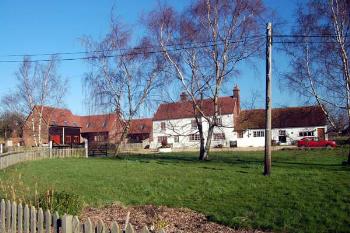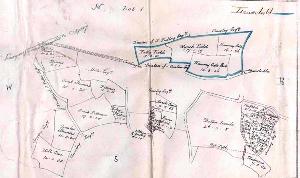Chaul End Farm

Chaul End Farm, March 2007
Chaul End Farm has long been an important part of the local landscape and today's farm is the result of hundreds of years of buying and selling various pieces of land so that the entity of the farm itself is difficult to trace. The following story is the best guess, pieced together from deeds in the Crawley family archive [ref: C] and Macnamara Archive [ref: MN].
In 1688 Thomas Chew, citizen and distiller of London granted a mortgage of £1,300 on a farm at Chaul End to its owner and occupier William Peddar, yeoman [ref: C758]. The farm comprised nearly 270 acres. Further advances followed in 1690, 1691, 1693, 1694 and 1696 making Pedder's debt a total of £3,112. Ten years later Chew joined Pedder in conveying the farm to John Coppin of Markyate Cell [Hertfordshire] for £2,096. All the money went to Chew, who had already been paid an additional £1,658 by Coppin. In 1778 Joseph Reynardson Coppin devised the farm to his sisters Ann and Sarah Reynardson and to Ann Fernyhough [ref: C759].
In 1769 a farm at Chaul End comprising 142 acres was in the hands of Thomas Birch and Elizabeth, his wife [ref: MN36/3]. Thomas died in 1774 and the farm passed to his widow Elizabeth, then living at Greenwich [Kent]. She and her son and heir Charles conveyed the farm to William Jones of Woburn in 1792 for £2,000 [ref: MN36/3-4].
In 1800 Caddington was inclosed, altering the composition of the land forming the farm which now comprised 168 acres, 1 rood, 25 perches [ref: MN36/5]. In 1811 Jones' son, William Hanbury Potter Jones of London sold the farm to Joseph Howell of Markyate Cell [Hertfordshire] for £5,420 [ref: MN36/7]. Howell died unmarried and intestate in 1819 and his estate passed to his surviving siblings and their children. A protracted series of actions in the Court of Chancery then took place lasting from 1825 until 1832 when the farm was conveyed to a trustee appointed by the court [MN36/17]. n 1820 over fifty acres in Chaul End was sold by John Goddard Marshall of Cambridgeshire, one of Joseph Howell's heirs to another of his heirs, John Patrick Moore of Aspley Guise for £2,300 [C760]. The land included "a newly erected messuage in Caddington". In 1821 Moore and his son John Vaux Moore joined Joseph Howell's heirs in conveying part of the farm, as well as Provender Farm and the Prebendary Manor of Caddington Minor to Samuel Crawley for a grand total of £9,427 [ref: C763]. A report of 1828 noted that repairs had been carried out at the farm but that the fences were still in a bad state and the land was better cultivated [ref: C767].
That same year Moore and others conveyed the other part of the farm in Chaul End which had belonged to Joseph Howell to James Warr for £3,780 [refs: MN36/23 and C785]. Sixty acres of the farm were conveyed by Warr to Samuel Crawley in 1838 [C839-840]. Warr sold the remainder of the farm to George Mellor of Woburn, draper, in 1844 for £3,600 [ref: MN36/27].
Thus the Crawley family acquired two substantial areas of land in Chaul End. The third acquisition took rather longer: Bedfordshire Archives has two sale catalogues of the farm, one from 1845 the other from 1898. The earlier of the two sale took place by auction on 16th December 1845 at Garraway's Coffee House in Change Alley, Cornhill and was by the trustees of the will of John Pedley. The farm is described thus [ref: MNuncat bundle11]:

MN Bundle 11 map - please click on it to see a larger image
"LOT 1. A VALUABLE FARM, of which the principal part is Freehold and the residue Leasehold, known as CHAUL END, situate in the parishes of Caddington and Luton, Bedfordshire, comprising 240 acres 0 roods 21 poles. of good sound productive Land, in high cultivation, with an ample and convenient homestead, well supplied with water; also two labourer's cottages.
This Estate is Tithe Free, with the exception of the Dollorlands, which are subject to the Tithe commutation rent charge of £1 15s. per annum, payable to the Vicar of Luton. These lands being contiguous to the Town of Luton, are likely to increase in value for building purposes and accommodation land.
The Dunstable Railway passes through this Estate.
Summary
Freehold 184 acres 3 roods 27 poles
Leasehold, held with other Lands under a lease from the Dean and Chapter of St.Paul's, of which the particulars are given at page 5 55 acres 0 roods 34 poles
Total 240 acres 0 roods 21 poles
The Farm was let to the late Mr.Bradshaw, for a term of six years from Michaelmas 1842, at the yearly rent of 26s. per statute acre calculated on all the lands (except the Downs, containing 16 acres 3 roods 22 poles which were thrown in) amounting together to £312, and is now in the occupation of his son, David Bradshaw".



To see larger images of these three parts of the map accompanying the sale of 1898 please click on each one
In 1890 Arthur Macnamara owned Chaul End Farm. In that year Stephen Sapwell and Ephraim Scrivenor became tenants [ref: BML6/6/1] though the farm was occupied on their behalf by a man named Cripps [ref: BML6/6/3] - presumably the Sidney George Cripps still holding part of the farm in 1927 (see below) or his son. A list of Macnamara's expenses as landlord from 1882 to 1887 survives [ref: BML6/2/7].
The second auction sale occurred on 7th July 1898 at The Mart, Tokenhouse Yard, London [ref: SH102/10]. As with the first sale Chaul End Farm was part of a much larger sale including Zouches Farm, Woodside Farm, Chalk Farm and other land. The vendor is not named but this is, presumably, the Macnamara Estate. Chaul End and Zouches Farms, together made up Lot Two. The farmhouse (presumably Chaul End) was described as containing two sitting rooms, a kitchen, dairy, pantry, wash-house, well-house, four bedrooms and a cellar; the homestead was described as containing a large barn, cart stables for thirteen horses with a loose box, a chaff house with a loft over, cow house for six beasts and a calf pen, frill house, wagon shed, poultry houses and three enclosed yards with stables. The bulk of the farm comprised 367 acres 1 rood 22 poles. The lot was coloured green on the accompanying map (see above).
The Rating and Valuation Act 1925 stipulated that every building and piece of land in the country was to be assessed to determine it rateable value. Chaul End Farm was assessed in September 1926. The valuer found that there were now two farms called Chaul End Farm. One included the historic farmhouse and the buildings immediately surrounding it: this was occupied by C. R. Clarke & Son. the other was based around the farm buildings imemdiately south of the farmhouse and was occupied by Sidney George Cripps.
Both farms were owned by Mrs. Ross Skinner, who lived at Stockwood House in Luton, and had been a Miss Crawley before her marriage. Presumably the Crawley family bought the farms in 1898 to add to their already sizable holdings in the area purchased in 1838 and 1839.
The larger farm was that occupied by C. R. Clarke & Son [ref: DV1/H24/22]. It included that old farmhouse ("poor damp") which was described as containing two reception rooms, a kitchen, a scullery, a pantry and a dairy with five bedrooms above. A W. C. stood outside. The rent was £250 per annum, set in 1923, and the farm comprised 266 acres, 2 roods. The valuer commented: "Fair house and buildings. tenant been here three years, says worth only 10/- an acre" as it was he paid nearly double that.
The homestead was divided into three sections and comprised the following:
- South-west yard: a brick, weather-boarded and corrugated iron barn with a chaff store at the end; a corrugated iron three bay open-fronted shed; a weather-boarded, corrugated iron and slated calf box, a larger calf box and another calf box with a loft over; a stone and timber four bay lean-to cow shed;
- North-west yard: a stone and weather-boarded chaff store; a brick, tiled and weather-boarded stable for eight horses; a stone and timber four bay open-fronted shed; three brick and tiled loose boxes, a fowl house and a trap house; a large corrugated iron and tin twelve bay open-fronted shed;
- Adjoining the house: a timber pump room and granary; a brick and slated cow house for sixteen with a loft over; a weather-boarded and corrugated iron loose box; a brick and corrugated iron two bay open-fronted shed.
The farmhouse was listed by the former Department of Environment in September 1980 as Grade II, of special interest. The building dates from the late 16th or early 17th century and is a timber-framed structure later refaced in brick. It comprises two storeys beneath a modern tiled roof. A 19th century wing in brick lies at the rear.
The other Chaul End Farm [ref: DV1/H24/24] was occupied at a rental of £137 per annum (though the valuer has writrten £159-7-8 in brackets) for 192 acres - before the Great War it had been 324 acres and the rent £219 per annum. the valuer commented: "Cold Ground. All wet land left with farm, 3 horse land, impossible for labour. 60 acres all grass at top of farm, no water have to cart it over a mile. Very good House and buildings but no drainage in yards, very wet. Rest sold to Wilkerson1918-9".
The "big...too big" house comprised a hall ("good"), three reception rooms, a kitchen, a scullery, a larder and a pantry with five bedrooms above along with a bathroom with a W. C. The homestead was in a number of localities and comprised the following:
- East Yard: a brick and slated cow house for six beasts; a food store; four loose boxes; a shed; an eight bay open-fronted cow shed; a stables for ten ("good") with a chaff store in them; a root store; a loose box and a dairy;
- Adjoining the house: a brick and slate nag stable for two; a trap house; a wood shed and an earth closet;
- West Yard: a three bay open-fronted shed; a granary with a loft over; a barn; a large loose box and a four bay open fronted shed;
- By the road: a brick and corrugated iron four bay cart shed; an implement shed and a lean-to implement shed;
- In the rickyard: a thatch and boarded range of lambing pens.
List of sources at Bedfordshire Archives:
- C758: Conveyance (abstract): £2,096, 1698
- MN36: Chaul End Farm documents, 1777-1852
- C759: Abstract of the will of Joseph Reynardson Coppin, 1778
- BML6/2/7: Statements: of payment for expenses incurred by Mr. Macnamara on his landed estates, 1881-1887
- BML6/6/3: Particulars of farms and sundry occupations, 1881-1893
- BML6/6/1: Tenancy Agreements, 1899-1909
- DV1/H24: No. 24 - Valuation Book, 1927